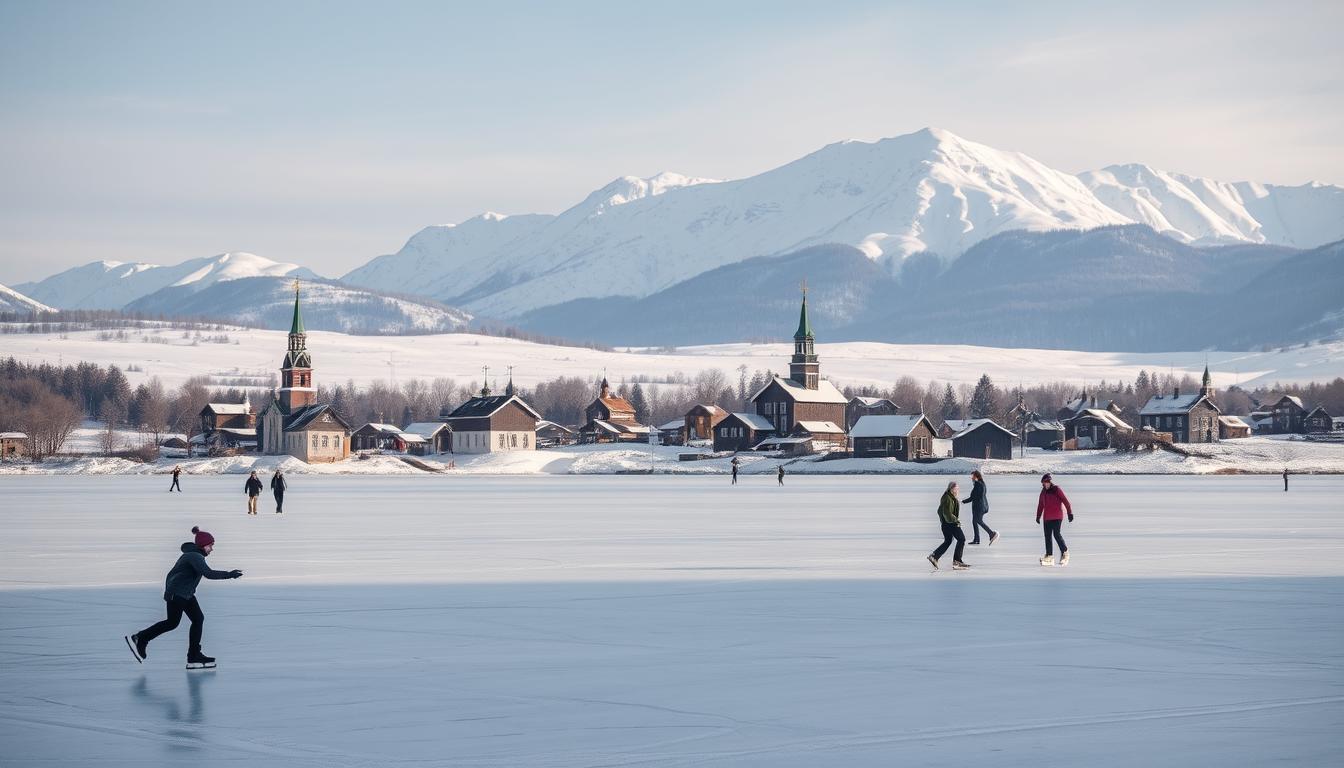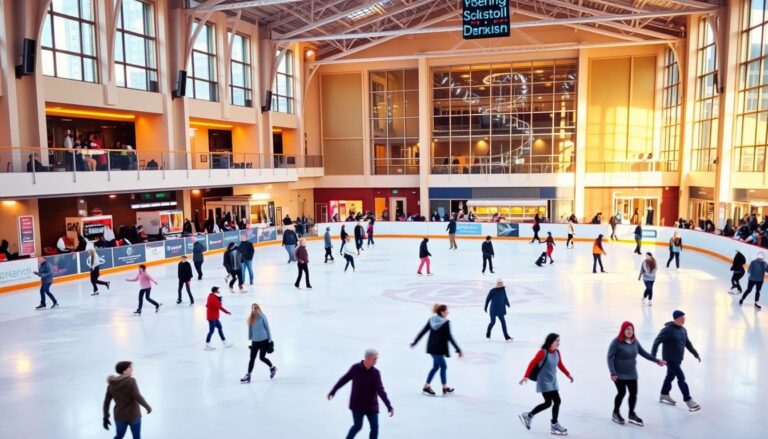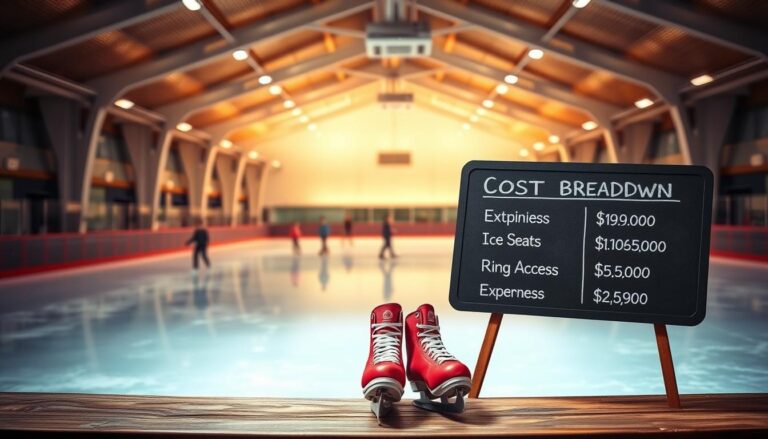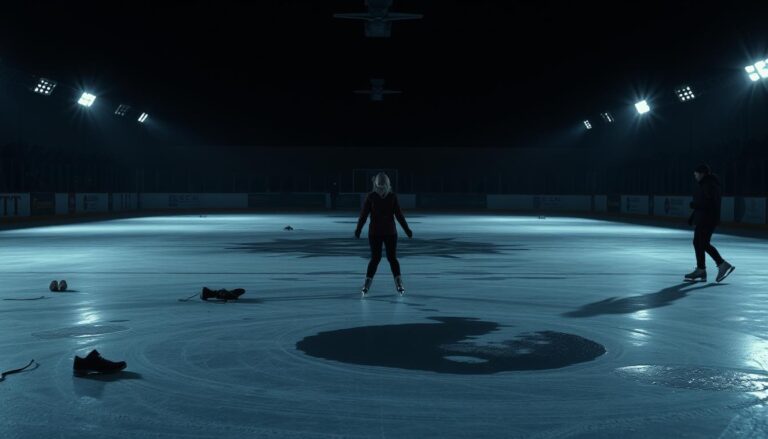The Origins of Ice Skating: A Fascinating History
Ice skating has its roots in human survival and innovation. It started as a way to cross frozen landscapes, evolving into a popular sport worldwide. Archaeological finds show humans sliding on ice for thousands of years.
Early ice skating was far from the smooth glide we see today. Skaters used animal bones to make simple tools for their feet. These tools helped ancient people move safely on frozen lakes and rivers in winter.
The history of ice skating is found in Northern Europe. Scandinavian sites have bone skates from 3000 BCE. This shows how important skating was for survival. Hunters, traders, and explorers used it to travel long distances on ice.
Learning about ice skating history shows how humans adapted. What started as a survival tool became a complex sport. From bone skates to modern gear, it shows our creativity and drive to conquer challenges.
Every artifact tells a story of innovation. Bone pieces in archaeological sites share tales of ancient people who turned winter’s cold into a chance for movement and connection. Ice skating’s origins are more than a way to travel; they symbolize human strength.
Thinking about the first skaters, we see their bravery. They didn’t just glide on ice; they started a global phenomenon. They linked survival skills with artistic expression.
When Was Ice Skating Invented: Tracing Ancient Origins
The history of ice skating goes back thousands of years. It shows how humans were creative and resourceful. Early ice skating was not the elegant sport we see today. It was a vital way for our ancestors to survive.
Archaeologists have found important clues about ice skating’s origins. They’ve discovered artifacts that tell us about early skating practices in various cultures.
Archaeological Evidence of Early Skates
The oldest ice skates date back to prehistoric times. These discoveries show the ingenuity of ancient people. Archaeologists have found artifacts that show how early humans coped with winter:
- Bone skates from Finland, dating back to 4000 BCE
- Skates made from animal bones and leather straps
- Proof of early ice skating in Scandinavian sites
Carbon Dating Discoveries
Science has given us a deeper look into the history of skating equipment. Carbon dating has helped figure out when these artifacts were made. It shows that ice skating is much older than we thought.
First Documented Ice Skating Activities
Old writings tell us how our ancestors used ice skating. Early ice skating was not for fun but for getting around on ice. It helped them survive and move goods.
Research shows that ancient Nordic societies used skating to cross frozen rivers. This was key for their survival and trade.
Prehistoric Ice Skating: Survival and Transportation
Ice skating started long ago, when people needed new ways to move around. Early humans found clever ways to glide on ice. This skill helped them survive and later became a fun activity.
Studies show that ice skating began around 3000 BCE in Finland and Sweden. People made their own skates from what they found in nature:
- Animal bones as primitive skate blades
- Leather straps for securing makeshift skates
- Wooden platforms to distribute weight across icy surfaces
These early skates were not for fun but for survival. Hunters and traders used them to move fast on ice. This made traveling in cold weather much easier.
Researchers have found interesting facts about ancient skating. They found bones that show people knew how to balance on ice. These early steps helped create the ice skating we know today.
The way ancient people skated shows their amazing creativity. They found ways to overcome tough challenges with smart ideas.
Ancient Nordic Civilizations and Ice Skating Culture
The history of ice skating is filled with survival and innovation in the Nordic regions. Ancient Nordic people turned ice skating from a survival tool into a cultural practice. This practice would shape ice skating for centuries.
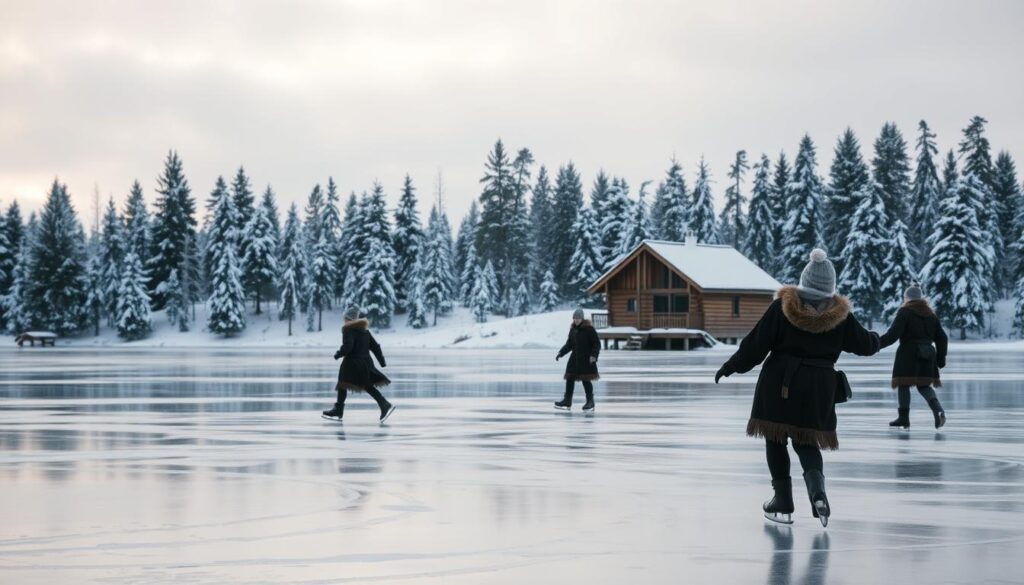
Nordic people found ways to move through frozen landscapes. Their strategies for winter travel and survival showed great adaptability in tough environments.
Finnish Ice Skating Traditions
Finnish communities made ice skating a key social and practical skill. They used luistimet (traditional Finnish skates) for:
- Traveling between settlements
- Hunting on frozen lakes
- Keeping in touch during long winters
Norwegian Contributions to Early Skating
Norwegian explorers improved ice skating techniques. They made skates from bone and wood. These allowed for faster travel on ice.
Swedish Ice Transportation Methods
Swedish communities led in using ice skates for transport. Traders and messengers traveled long distances. They carried goods and information on frozen landscapes.
The Nordic way of ice skating changed it from a survival tool to a cultural cornerstone. It influenced ice skating worldwide.
Evolution of Ice Skate Design Through the Ages
The journey of ice skating is filled with human creativity and innovation. It has moved from simple bone skates to advanced technology. This shows a big change in design and how they work.
At first, people used animal bones and leather boots to skate. This was a clever way to move on ice. It was the start of a long journey in making better skates.
- Bone skates: First primitive ice skating equipment
- Wooden platforms: Initial improvements in design
- Metal blades: Revolutionary breakthrough in skating technology
- Specialized modern skates: Discipline-specific innovations
In the Middle Ages, craftsmen in Europe started using better materials. Iron-edged skates were made, which helped people glide and control better. The Netherlands was key in making these skates even better.
The industrial revolution changed ice skating forever. Skates were made with new materials and techniques. This led to sharper blades, better boots, and improved performance.
Today’s ice skates are the result of all this progress. They use carbon fiber, metals, and are designed for comfort. Skates for different sports show how far we’ve come.
Every new skate design has made ice skating better. It has turned a basic way to move into a sport and art form.
Medieval European Ice Skating Developments
In the medieval times, ice skating evolved from a basic survival skill to a refined art form. It started to gain popularity in European societies, mainly among the nobility and city dwellers. Frozen rivers and lakes turned into lively spots for socializing and showing off skating skills.
Across Europe, winter landscapes saw big changes in skating techniques and social norms. The history of ice skating shows how different areas adapted to cold weather.
Royal Courts and Ice Skating Entertainment
European royal courts made ice skating a sophisticated form of entertainment. Kings and nobles organized grand winter festivals where skating was seen as a sign of elegance and status. Skaters were celebrated for their skill and creativity.
- Skating performances became popular court entertainment
- Nobility commissioned specialized skating attire
- Winter festivals showcased skating skills
Dutch Golden Age Skating Culture
The Netherlands played a key role in the early history of ice skating. Dutch artists depicted the lively skating culture in their works, capturing frozen canals and winter scenes. Skating became deeply intertwined with national identity, moving from a practical need to a cherished pastime.
| Dutch Skating Characteristics | Cultural Significance |
|---|---|
| Frozen Canal Networks | Primary Social Gathering Space |
| Specialized Skating Equipment | Technological Innovation |
| Community Winter Festivals | Social Bonding Ritual |
The Dutch Golden Age marked a significant time in ice skating history. It laid the groundwork for techniques and cultural practices that shaped skating globally for centuries.
The Rise of Recreational Ice Skating
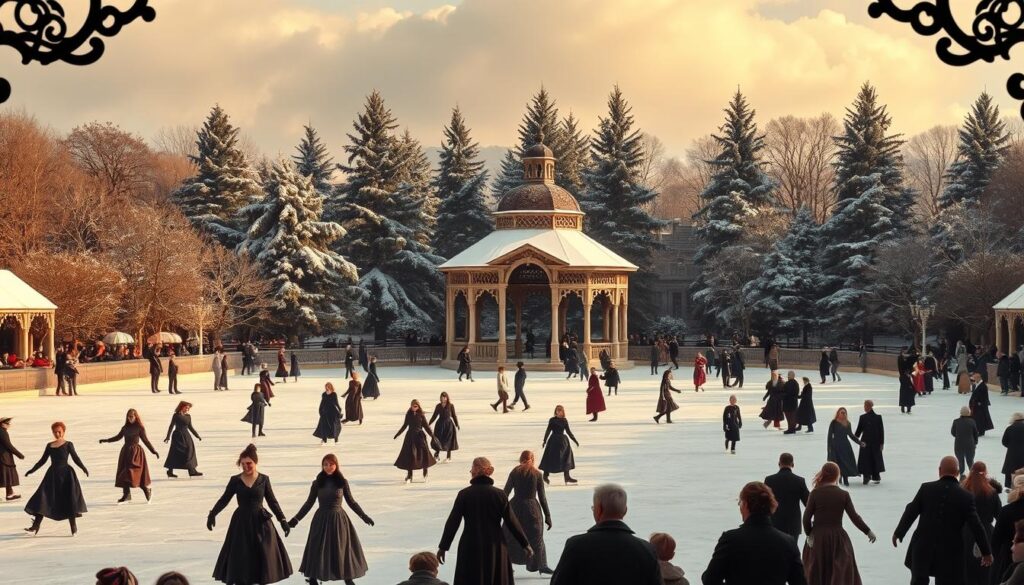
The 19th century saw a big change in ice skating. It moved from a survival tool to a favorite pastime. New technologies played a big part in this change.
Thanks to artificial ice-making, skating could happen indoors. This meant people could skate no matter the weather. Cities began to open public skating areas for everyone to enjoy.
- First public ice rinks emerged in urban centers
- Artificial refrigeration made year-round skating possible
- Social attitudes toward physical recreation changed dramatically
The Victorian era was a time of big cultural shifts. Skating turned from a way to get around to a social event. Elegant winter sports became popular among the wealthy, seen as fun and good exercise.
New skate designs and better boots made skating easier and cheaper. This encouraged more people to try it. The history of ice skating shows a move from need to joy.
- Blade manufacturing became more sophisticated
- Skate designs became more ergonomic
- Recreational skating clubs started forming
By the early 20th century, ice skating was a beloved activity. It went from a practical need to a fun way to connect with others on the ice.
Industrial Revolution: Modern Ice Skate Manufacturing
The Industrial Revolution changed ice skating technology a lot. New manufacturing methods made skates better and cheaper. This changed how skates were made and used.
Before the Industrial Revolution, making ice skates was hard and expensive. Skilled workers made each pair by hand. This made skates a luxury for the rich. The 19th century brought new tech that made ice skating more common.
Technological Breakthroughs in Skate Design
Important changes happened during this time. They changed ice skating equipment a lot:
- Stainless steel blades made skates last longer
- New machines helped make skates faster
- Skates were made the same size and quality
- Sharpening blades got better
Mass Production Impact
Mass production changed ice skating a lot. Now, skates were:
- Made faster
- Cheaper
- More consistent in quality
- Available in many sizes
These changes made ice skating more popular. It went from being for the elite to a sport for many. Now, people everywhere could enjoy skating thanks to better, cheaper equipment.
Birth of Competitive Ice Skating
Ice skating changed from a simple winter activity to a competitive sport. Early fans started competing on frozen lakes and rivers. This sparked the first competitive skating events.
The start of competitive ice skating dates back to the mid-19th century. European countries were key in creating these events. They shaped the sport’s future.
- First organized skating competitions emerged in Nordic countries
- Initial events focused on speed and endurance
- Gradual introduction of artistic elements in skating performances
Important moments in competitive ice skating’s growth included:
- Development of standardized judging criteria
- Creation of specific skating disciplines
- Establishment of national and international skating organizations
The history of ice skating shows athletes constantly pushing limits. Figure skating and speed skating became distinct disciplines. Each needed its own skills and techniques.
By the late 19th century, competitive ice skating had grown. It became a sport that required skill, precision, and artistry.
Formation of International Skating Organizations
Ice skating grew from a local hobby to a global sport. This needed strong organizations to set rules and oversee competitions. As time went on, groups formed to make skating fair and organized worldwide.
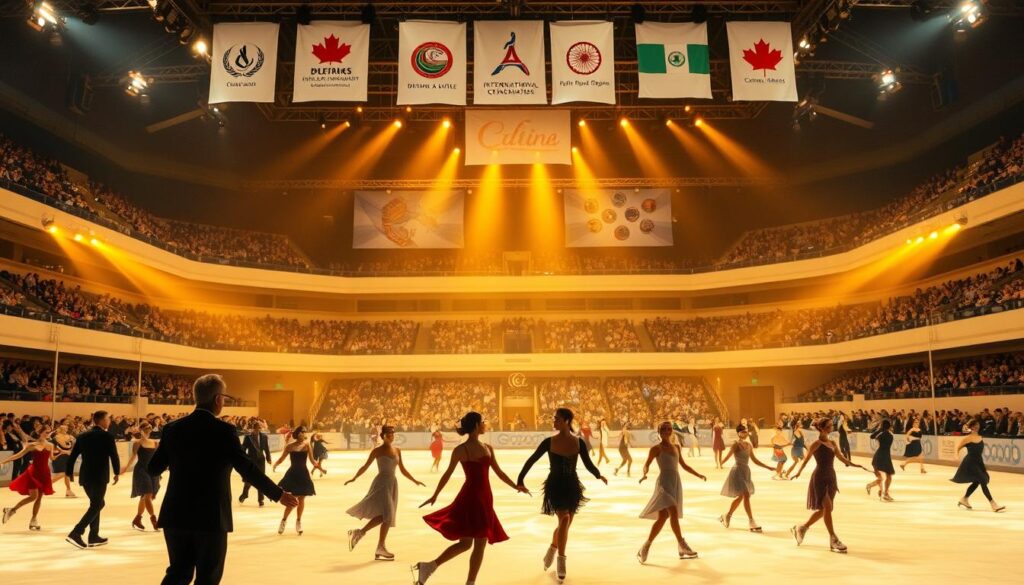
The story of these organizations is key in ice skating’s history. They turned local skating into a global sport with strict rules.
Pioneering Organizational Milestones
- 1892: International Skating Union (ISU) established in Netherlands
- 1908: First international skating championships organized
- 1924: Formation of national skating federations worldwide
- 1952: Standardized judging criteria introduced
Governance Structure Development
Skating groups built detailed plans for managing events and athlete rules. They made sure everyone followed the same rules. This made ice skating a recognized sport.
| Organization | Year Founded | Primary Focus |
|---|---|---|
| International Skating Union | 1892 | Global Competition Regulation |
| United States Figure Skating Association | 1921 | National Competition Management |
These groups worked together to make ice skating a respected sport. They created paths for athletes to compete worldwide.
Ice Skating in the Olympic Games
The Olympic Games made ice skating a global event. Ice skating history shows a journey of athletic greatness and worldwide recognition. Figure skating first appeared in the Winter Olympics in 1908, marking a key moment.
The Olympics featured various ice skating disciplines, each with its own challenges and stunning performances. Athletes from all over the world competed in major events:
- Men’s and women’s singles figure skating
- Pair skating competitions
- Ice dancing
- Speed skating events
Olympic competition sped up the sport’s growth. Technological innovations in equipment, training, and judging came from the Olympics. Skaters like Sonja Henie and Dick Button became international stars, boosting ice skating’s fame.
International fans were drawn to the beauty, strength, and skill of Olympic ice skating. The games allowed athletes to break new ground, creating more complex routines.
Now, Olympic ice skating is the top of human athletic achievement. It combines art and incredible physical ability.
Evolution of Figure Skating Techniques
The world of ice skating has seen a huge change. Figure skating techniques have pushed what humans can do on ice. This journey of art and skill is loved by fans all over the world.
Figure skating has grown from simple beginnings to a complex sport. It now combines strength and beauty. The history of ice skating shows how skaters have always tried to do more.
Revolutionary Moves and Innovations
New techniques have changed figure skating a lot. Skaters have made moves that have changed the sport:
- Quadruple jumps are now possible thanks to better training
- Spins have gone from simple to complex multi-rotational moves
- Footwork has become more detailed and challenging
Notable Historical Performances
Some performances have been key moments in figure skating. Athletes like Dick Button, Peggy Fleming, and Katarina Witt changed the sport with their new ideas.
Each performance was a step forward in art and skill. They inspired others to try new things.
Figure skating keeps getting better because of human creativity and skill. Today’s skaters use all the innovations from the past. They create amazing shows that mix strength with beauty.
Speed Skating: From Transportation to Sport

Speed skating started in the Nordic regions, where it was a way to move on ice. It was once just for getting around, but now it’s a thrilling sport. It shows how far humans can go in terms of speed and skill.
The history of ice skating is quite interesting. At first, people used skates to travel in the winter. They moved on frozen rivers and snow. This early use helped create the speed skating we know today.
- Primitive skates made from animal bones
- Wooden platforms with metal blades
- Specialized racing designs emerged in the 19th century
By the late 1800s, speed skating became a real sport. The Netherlands was a big part of this, starting races. Skaters learned how to move fast and use less energy.
Today, speed skating has two main types:
- Long-track racing: Olympic events on big oval tracks
- Short-track racing: Fast, tight races with many skaters
New technology has made speed skating even more exciting. Skaters wear special suits and use advanced blades. They also train in new ways, making the sport more challenging and rewarding.
Cultural Impact of Ice Skating Through History
Ice skating is more than just a sport. It’s a powerful way to express culture that has touched many lives. Its history shows a mix of art and social importance, reaching across the world and time.
Ice skating has shown its cultural strength through the ages. Artists have used many ways to show its beauty:
- Paintings of winter scenes with skaters
- Stories that use skating to talk about human life
- Movies that highlight the sport’s exciting side
Skating has always brought people together. It’s been a key part of social events and winter festivals. From old European markets to today’s holiday parties, it connects people across ages and cultures.
The sport’s reach goes beyond fun activities. It has shaped:
- Winter fashion with special clothes
- Music inspired by skating’s rhythm
- Designs for indoor rinks
Ice skating is not just about moving. It’s a living cultural language that keeps changing, showing how society and creativity evolve.
Modern Ice Skating Technology and Innovation
The world of ice skating is changing fast with new tech. New technologies are changing how athletes train and compete. They also change how we enjoy the sport.
Looking back, we see big changes in equipment and tracking. Today’s skaters have better gear that helps them skate better and safer.
Contemporary Equipment Advances
Modern ice skating equipment has cool tech:
- Carbon fiber makes blades lighter
- Boots now keep your feet warm or cool
- Sensors track how you move
- Custom parts fit just right
Future Technological Trends
New tech will change ice skating even more:
- Smart Skates: Track your moves digitally
- Try training in virtual reality
- AI helps improve your skills
- Adaptive blades adjust to your style
Researchers and makers are always looking to improve. They’re making ice skating more exciting and advanced for everyone.
Conclusion
The history of ice skating is truly amazing. It started as a way to survive in cold weather and grew into a loved sport around the world. People’s creativity and hard work have made ice skating what it is today.
Ice skating shows how people can turn something useful into something beautiful. It began as a way to move in winter in the North and now it’s a sport that combines skill, art, and technology. From old bone skates to modern ones, each time has added to ice skating’s story.
Ice skating tells a story of human creativity, adaptation, and sharing cultures. Champions, new technologies, and fans have made it a sport loved by many. It has grown from a simple survival tool to a global sport that excites millions.
The future of ice skating looks bright. With new materials, better training, and more fans, it’s ready for its next chapter. Every skater today is part of a long history of human effort and beauty on ice.
